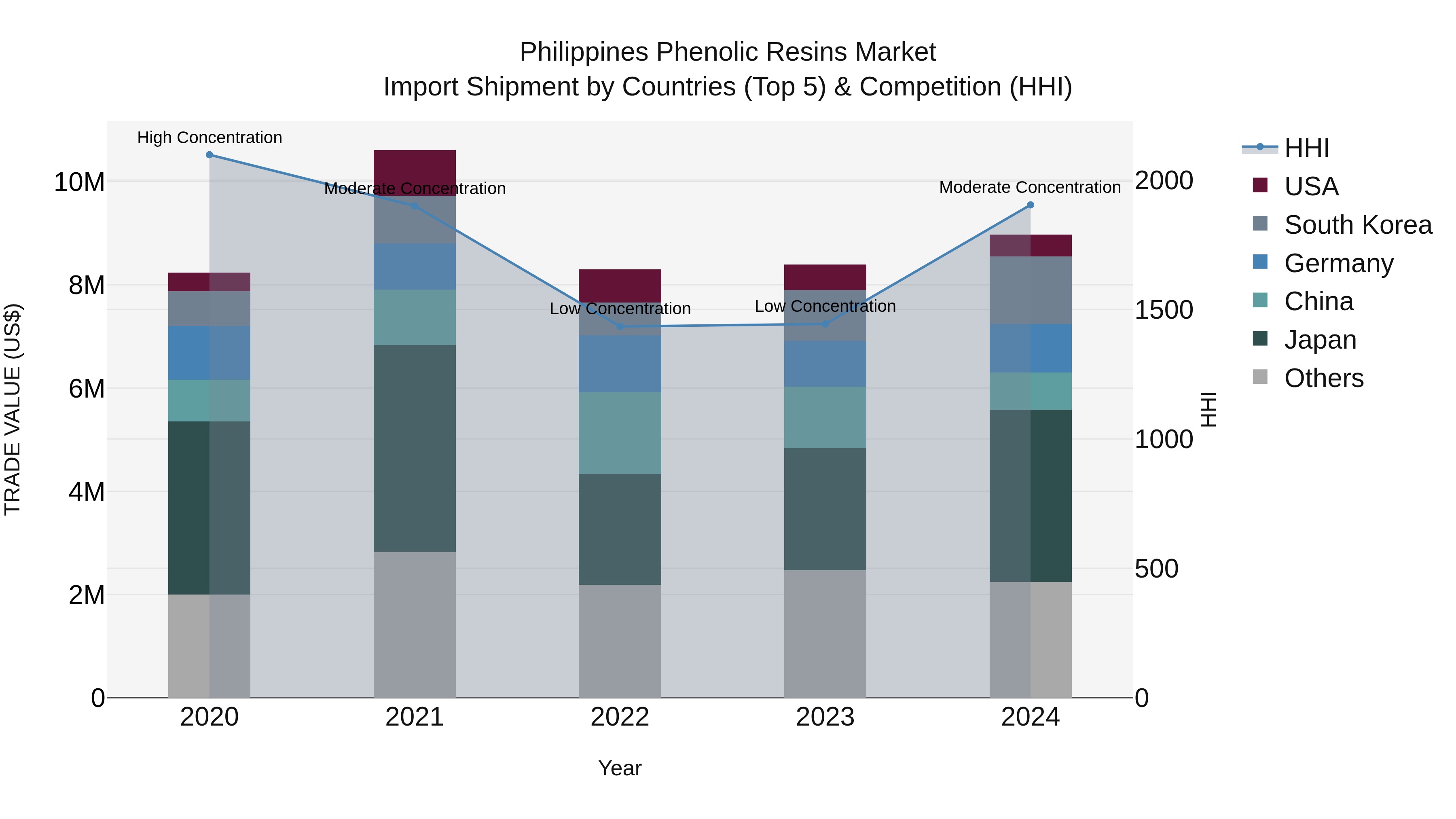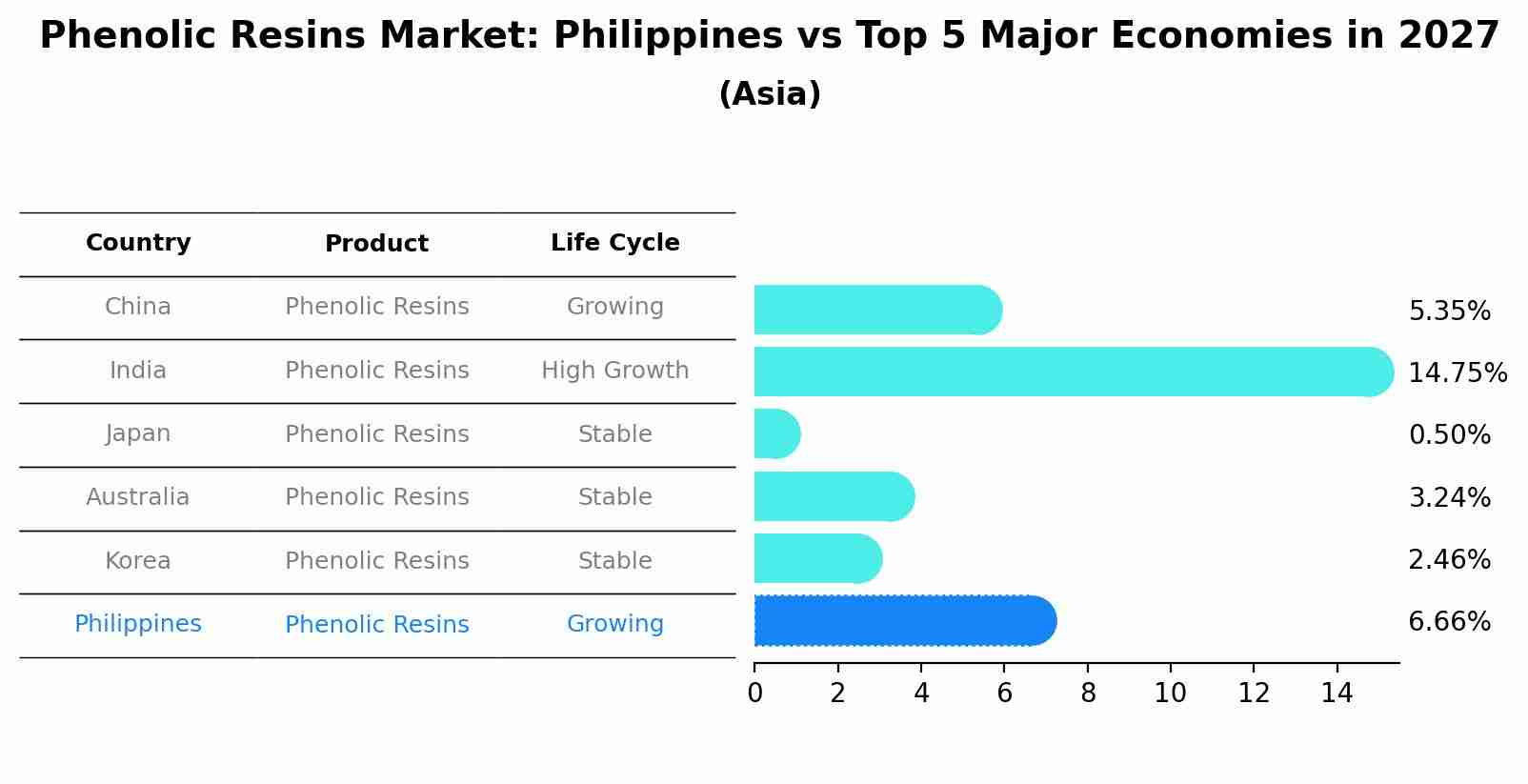Philippines Phenolic Resins Market (2025-2031) Outlook | Companies, Size, Industry, Value, Revenue, Trends, Forecast, Share, Growth & Analysis
| Product Code: ETC081828 | Publication Date: Jun 2021 | Updated Date: Nov 2025 | Product Type: Report | |
| Publisher: 6Wresearch | Author: Ravi Bhandari | No. of Pages: 70 | No. of Figures: 35 | No. of Tables: 5 |
Philippines Phenolic Resins Market Top 5 Importing Countries and Market Competition (HHI) Analysis
The Philippines` phenolic resins import market saw notable growth in 2024, with key exporting countries like Japan, South Korea, and Germany leading the way. The shift from low to moderate concentration in the Herfindahl-Hirschman Index indicates a changing competitive landscape. The compound annual growth rate (CAGR) of 2.17% from 2020 to 2024 highlights steady expansion, while the impressive growth rate of 6.95% from 2023 to 2024 signals accelerating momentum. This data suggests a positive outlook for the phenolic resins import market in the Philippines, driven by diverse sources and increasing market competitiveness.

Phenolic Resins Market: Philippines vs Top 5 Major Economies in 2027 (Asia)
The Phenolic Resins market in Philippines is projected to grow at a growing growth rate of 6.66% by 2027, highlighting the country's increasing focus on advanced technologies within the Asia region, where China holds the dominant position, followed closely by India, Japan, Australia and South Korea, shaping overall regional demand.

Philippines Phenolic Resins Market Synopsis
The Philippine phenolic resins market was valued at USD 3.9 million in 2025 and is projected to reach USD 5.5 million with a CAGR of 7%. Growing applications across automobile components such as wheels hubs & brake discs; oil seals; fuel tanks; electrical wiring harnesses etc., is one key factor driving its demand. In addition, increased consumption from furniture industry due to rapid urbanization has also contributed significantly towards its overall growth across the country over last few years. Furthermore, rising awareness among manufacturers regarding energy efficiency benefits offered by these resins coupled with cost effectiveness will further help stimulate product demand thereby propelling Philippine phenolic resin industry outlook up until 2025.
Drivers of the market
The Philippines phenolic resins market has witnessed substantial growth owing to the thriving wood and construction industries. Phenolic resins find extensive use in wood adhesives, contributing to the growth of the furniture and construction sectors. Moreover, the growing electrical and electronics industry in the Philippines has increased the demand for phenolic resins in manufacturing electrical components and insulating materials. Additionally, the country`s efforts to improve infrastructure and focus on sustainable building materials have positively impacted the phenolic resins market.
Challenges of the market
The Philippines Phenolic Resins Market has experienced significant growth owing to rising demand from industries like construction, automotive, and electronics. Nonetheless, the market confronts certain challenges. One major challenge is the growing competition from alternative resins, which may hinder market expansion. Moreover, fluctuations in raw material prices, especially for phenol and formaldehyde, can impact the profitability of phenolic resin manufacturers. Additionally, the lack of advanced production technologies and limited research and development efforts in the country may impede innovation and product diversification.
Covid-19 Impact of the market
The Philippines phenolic resins market faced challenges during the COVID-19 crisis. The construction and automotive sectors, major consumers of phenolic resins, were adversely affected by lockdowns and supply chain disruptions, leading to reduced demand and production.
Key Players of the market
In the Philippines Phenolic Resins Market, key players include companies such as Hexion Inc., Georgia-Pacific Chemicals LLC, and SI Group Inc. These companies are prominent manufacturers of phenolic resins and serve various industries, including construction, automotive, and electronics.
Key Highlights of the Report:
- Philippines Phenolic Resins Market Outlook
- Market Size of Philippines Phenolic Resins Market, 2024
- Forecast of Philippines Phenolic Resins Market, 2031
- Historical Data and Forecast of Philippines Phenolic Resins Revenues & Volume for the Period 2021-2031
- Philippines Phenolic Resins Market Trend Evolution
- Philippines Phenolic Resins Market Drivers and Challenges
- Philippines Phenolic Resins Price Trends
- Philippines Phenolic Resins Porter's Five Forces
- Philippines Phenolic Resins Industry Life Cycle
- Historical Data and Forecast of Philippines Phenolic Resins Market Revenues & Volume By Product for the Period 2021-2031
- Historical Data and Forecast of Philippines Phenolic Resins Market Revenues & Volume By Novolac for the Period 2021-2031
- Historical Data and Forecast of Philippines Phenolic Resins Market Revenues & Volume By Resol for the Period 2021-2031
- Historical Data and Forecast of Philippines Phenolic Resins Market Revenues & Volume By Others for the Period 2021-2031
- Historical Data and Forecast of Philippines Phenolic Resins Market Revenues & Volume By Application for the Period 2021-2031
- Historical Data and Forecast of Philippines Phenolic Resins Market Revenues & Volume By Wood Adhesives for the Period 2021-2031
- Historical Data and Forecast of Philippines Phenolic Resins Market Revenues & Volume By Molding for the Period 2021-2031
- Historical Data and Forecast of Philippines Phenolic Resins Market Revenues & Volume By Insulation for the Period 2021-2031
- Historical Data and Forecast of Philippines Phenolic Resins Market Revenues & Volume By Laminates for the Period 2021-2031
- Historical Data and Forecast of Philippines Phenolic Resins Market Revenues & Volume By Paper Impregnation for the Period 2021-2031
- Historical Data and Forecast of Philippines Phenolic Resins Market Revenues & Volume By Coatings for the Period 2021-2031
- Historical Data and Forecast of Philippines Phenolic Resins Market Revenues & Volume By Others for the Period 2021-2031
- Philippines Phenolic Resins Import Export Trade Statistics
- Market Opportunity Assessment By Product
- Market Opportunity Assessment By Application
- Philippines Phenolic Resins Top Companies Market Share
- Philippines Phenolic Resins Competitive Benchmarking By Technical and Operational Parameters
- Philippines Phenolic Resins Company Profiles
- Philippines Phenolic Resins Key Strategic Recommendations
Frequently Asked Questions About the Market Study (FAQs):
1 Executive Summary |
2 Introduction |
2.1 Key Highlights of the Report |
2.2 Report Description |
2.3 Market Scope & Segmentation |
2.4 Research Methodology |
2.5 Assumptions |
3 Philippines Phenolic Resins Market Overview |
3.1 Philippines Country Macro Economic Indicators |
3.2 Philippines Phenolic Resins Market Revenues & Volume, 2021 & 2031F |
3.3 Philippines Phenolic Resins Market - Industry Life Cycle |
3.4 Philippines Phenolic Resins Market - Porter's Five Forces |
3.5 Philippines Phenolic Resins Market Revenues & Volume Share, By Product, 2021 & 2031F |
3.6 Philippines Phenolic Resins Market Revenues & Volume Share, By Application, 2021 & 2031F |
4 Philippines Phenolic Resins Market Dynamics |
4.1 Impact Analysis |
4.2 Market Drivers |
4.3 Market Restraints |
5 Philippines Phenolic Resins Market Trends |
6 Philippines Phenolic Resins Market, By Types |
6.1 Philippines Phenolic Resins Market, By Product |
6.1.1 Overview and Analysis |
6.1.2 Philippines Phenolic Resins Market Revenues & Volume, By Product, 2021-2031F |
6.1.3 Philippines Phenolic Resins Market Revenues & Volume, By Novolac, 2021-2031F |
6.1.4 Philippines Phenolic Resins Market Revenues & Volume, By Resol, 2021-2031F |
6.1.5 Philippines Phenolic Resins Market Revenues & Volume, By Others, 2021-2031F |
6.2 Philippines Phenolic Resins Market, By Application |
6.2.1 Overview and Analysis |
6.2.2 Philippines Phenolic Resins Market Revenues & Volume, By Wood Adhesives, 2021-2031F |
6.2.3 Philippines Phenolic Resins Market Revenues & Volume, By Molding, 2021-2031F |
6.2.4 Philippines Phenolic Resins Market Revenues & Volume, By Insulation, 2021-2031F |
6.2.5 Philippines Phenolic Resins Market Revenues & Volume, By Laminates, 2021-2031F |
6.2.6 Philippines Phenolic Resins Market Revenues & Volume, By Paper Impregnation, 2021-2031F |
6.2.7 Philippines Phenolic Resins Market Revenues & Volume, By Coatings, 2021-2031F |
7 Philippines Phenolic Resins Market Import-Export Trade Statistics |
7.1 Philippines Phenolic Resins Market Export to Major Countries |
7.2 Philippines Phenolic Resins Market Imports from Major Countries |
8 Philippines Phenolic Resins Market Key Performance Indicators |
9 Philippines Phenolic Resins Market - Opportunity Assessment |
9.1 Philippines Phenolic Resins Market Opportunity Assessment, By Product, 2021 & 2031F |
9.2 Philippines Phenolic Resins Market Opportunity Assessment, By Application, 2021 & 2031F |
10 Philippines Phenolic Resins Market - Competitive Landscape |
10.1 Philippines Phenolic Resins Market Revenue Share, By Companies, 2024 |
10.2 Philippines Phenolic Resins Market Competitive Benchmarking, By Operating and Technical Parameters |
11 Company Profiles |
12 Recommendations |
13 Disclaimer |
- Single User License$ 1,995
- Department License$ 2,400
- Site License$ 3,120
- Global License$ 3,795
Search
Thought Leadership and Analyst Meet
Our Clients
Related Reports
- Germany Breakfast Food Market (2026-2032) | Industry, Share, Growth, Size, Companies, Value, Analysis, Revenue, Trends, Forecast & Outlook
- Australia Briquette Market (2025-2031) | Growth, Size, Revenue, Forecast, Analysis, Trends, Value, Share, Industry & Companies
- Vietnam System Integrator Market (2025-2031) | Size, Companies, Analysis, Industry, Value, Forecast, Growth, Trends, Revenue & Share
- ASEAN and Thailand Brain Health Supplements Market (2025-2031) | Strategy, Consumer Insights, Analysis, Investment Trends, Opportunities, Growth, Size, Share, Industry, Revenue, Segments, Value, Segmentation, Supply, Forecast, Restraints, Outlook, Competition, Drivers, Trends, Demand, Pricing Analysis, Competitive, Strategic Insights, Companies, Challenges
- ASEAN Bearings Market (2025-2031) | Strategy, Consumer Insights, Analysis, Investment Trends, Opportunities, Growth, Size, Share, Industry, Revenue, Segments, Value, Segmentation, Supply, Forecast, Restraints, Outlook, Competition, Drivers, Trends, Demand, Pricing Analysis, Competitive, Strategic Insights, Companies, Challenges
- Europe Flooring Market (2025-2031) | Outlook, Share, Industry, Trends, Forecast, Companies, Revenue, Size, Analysis, Growth & Value
- Saudi Arabia Manlift Market (2025-2031) | Outlook, Size, Growth, Trends, Companies, Industry, Revenue, Value, Share, Forecast & Analysis
- Uganda Excavator, Crane, and Wheel Loaders Market (2025-2031) | Strategy, Consumer Insights, Analysis, Investment Trends, Opportunities, Growth, Size, Share, Industry, Revenue, Segments, Value, Segmentation, Supply, Forecast, Restraints, Outlook, Competition, Drivers, Trends, Demand, Pricing Analysis, Competitive, Strategic Insights, Companies, Challenges
- Rwanda Excavator, Crane, and Wheel Loaders Market (2025-2031) | Strategy, Consumer Insights, Analysis, Investment Trends, Opportunities, Growth, Size, Share, Industry, Revenue, Segments, Value, Segmentation, Supply, Forecast, Restraints, Outlook, Competition, Drivers, Trends, Demand, Pricing Analysis, Competitive, Strategic Insights, Companies, Challenges
- Kenya Excavator, Crane, and Wheel Loaders Market (2025-2031) | Strategy, Consumer Insights, Analysis, Investment Trends, Opportunities, Growth, Size, Share, Industry, Revenue, Segments, Value, Segmentation, Supply, Forecast, Restraints, Outlook, Competition, Drivers, Trends, Demand, Pricing Analysis, Competitive, Strategic Insights, Companies, Challenges
Industry Events and Analyst Meet
Whitepaper
- Middle East & Africa Commercial Security Market Click here to view more.
- Middle East & Africa Fire Safety Systems & Equipment Market Click here to view more.
- GCC Drone Market Click here to view more.
- Middle East Lighting Fixture Market Click here to view more.
- GCC Physical & Perimeter Security Market Click here to view more.
6WResearch In News
- Doha a strategic location for EV manufacturing hub: IPA Qatar
- Demand for luxury TVs surging in the GCC, says Samsung
- Empowering Growth: The Thriving Journey of Bangladesh’s Cable Industry
- Demand for luxury TVs surging in the GCC, says Samsung
- Video call with a traditional healer? Once unthinkable, it’s now common in South Africa
- Intelligent Buildings To Smooth GCC’s Path To Net Zero


















